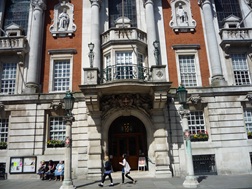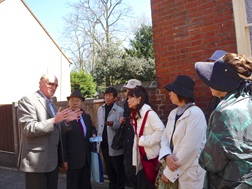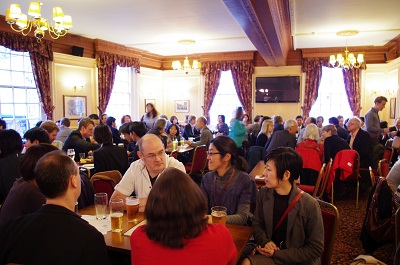Professor of English and British Studies at Shigakukan University, Sumiyuki Sakasegawa, President of the Japan British Society of Kagoshima reports on the society's recent visit to the UK.
|
The Japan British Society of Kagoshima, founded in 1992 to further promote cultural exchanges between the UK and Kagoshima (a prefecture located at the southwestern tip of the island of Kyushu), organised a UK trip to commemorate the 150th anniversary of the Anglo-Satsuma War of 1863, and nine people visited Britain from 27 April to 4 May.
|
One of our important destinations was a monument erected in the Rectangle Court at UCL to the memory of Satsuma Students and the Choshu Five (click here for more details) who studied at UCL in the 1860s. Two years after the Anglo-Satsuma War, triggered by the murder by Satsuma samurai of an English merchant in Yokohama in the previous year, Satsuma sent to Britain young samurai: a 19-member delegation (three envoys, 15 students, and one interpreter, including two from other clans) in order to acquire advanced Western technologies.
Satsuma had been shocked at the apparent superiority and advanced technologies and weaponry of the British fleet. The samurai students (except Nagasawa Kanae, the youngest) studied at UCL, and after going back to Japan worked as the driving force of the modernisation of Japan. Among the students, most of whom later became prominent in various fields, were Mori Arinori, the first minister of education, Hatakeyama Yoshinari, the first headmaster of Kaisei Gakko (present Tokyo University) and Machida Hisanari, the first curator of the Imperial Museum (present Tokyo National Museum).
At the monument Prof. Shin-ichi Ohnuma of UCL kindly gave us a brief talk about the memorial and recent academic ties between the UCL, Britain and Japan. Prof Ohnuma also took us to the building in Gower Street where some Choshu and Satsuma students lived.
|
|
In the past 150 years there have been various exchanges both public and private between the UK and Kagoshima, and hundreds of university students have taken part in home-stay and English study programmes in London. The Anglo-Satsuma War, as it turned out, forged deep bonds of friendship between the UK and Kagoshima.
As places also remembered for their associations with the Satsuma students and Togo Heihachiro, we visited Southampton and Portsmouth. Southampton was the place where both the Satsuma samurai students and Togo (who studied navigation and seamanship at Portsmouth and Greenhithe, Kent for seven years and was called the ‘Nelson in the Orient’ after his victory in 1905 over the Russian Baltic Fleet in the Russo-Japanese War) landed before they moved to London by train. At Portsmouth, we visited the Historic Dockyard and were able to go onboard the Victory on which Togo underwent training on many occasions. Togo attended a naval training academy at Gosport which lies on a peninsula on the western side of Portsmouth Harbour opposite the City of Portsmouth. Before entering the theme park, we smacked appreciative lips over traditional pub dishes of fish and chips, steak and kidney pie, and sausage and mash accompanied by lager at a pub nearby named The Lady Hamilton, a pub whose walls were filled with paintings of Lord Nelson and his mistress Lady Hamilton. It was so nice to 'breathe the same air' of the places where our highly respectable predecessors once stayed.
|

 At Colchester with Mr Patrick Denny
At Colchester with Mr Patrick Denny
|
Another Kagoshima-related destination was Colchester where Isaac Bunting, the ‘discoverer’ of Erabu-lily (Lilium longiflorum), was born and worked when young for his family nursery business before going to Yokohama, Japan in 1874 and establishing his own business of nursery and tailoring in 1877. During a plant collecting journey in 1898, he got shipwrecked in the offing of Okierabu Island, Kagoshima, but was, so goes the legend, fortunately rescued by islanders. While on a walk after his recovery, he saw and was greatly impressed by the beauty and abundance of white lilies growing wild on the island, and urged the islanders to collect bulbs for him. Two years later he returned to the island and bought the collected lily bulbs with an amazingly large amount of money, thus helping the island prosper as ‘an island of lilies ‘ever since. The islanders still feel indebted and cherish respects to him.
At Colchester Mr Patrick Denny, a university lecturer, local historian, author, and blue badge guide, kindly showed us in and around the Town Hall where Isaac Bunting and his family members were often invited as noted businessmen to the annual Oyster Feast, which is still held in late October and said to date back at least to the 1790’s. Patrick and I had met 10 years before when I started to research Isaac Bunting and visited Mrs Prue James, descendant of the Buntings and researcher of Isaac Bunting. |
We also visited the Hythe where Isaac had a warehouse and his junior partner unpacked and redistributed the lily bulbs from Japan to dealers in and out of Britain as well as the Buntings and Sons. ‘Bunting lilies’ became very popular and were provided to, among others, the Covent Garden Market, St Paul’s Cathedral and Buckingham Palace. I gave a brief ‘lecture’ on Isaac Bunting and Erabu lily to the employees of a garage on the site of Isaac’s warehouse who had no knowledge about them.
|
Another highlight of our stay in London was a very pleasant pub quiz, a popular feature of British pub culture, held in the function room at The Prince of Wales, Drury Lane, Covent Garden on the evening of 30 April. It was, to our great honour, kindly organised by the Japan Society to mark our visit and promote exchange between members of the Japan Society, the Japanese Embassy in the UK, and the Japan British Society of Kagoshima. The quiz was prepared and emceed by Mr Simon Wright, senior coordinator for cultural affairs at the Japan Information and Cultural Centre, and ‘fought’ by over ten teams each consisting of both British and Japanese participants. Half of the well-structured questions on Kagoshima and Britain yesterday and today were in English and half in Japanese and everyone could take part and enjoy. Over a drink or two along the way we had a jolly good time and made friends with a lot of people.
|
 Pub quiz at The Prince of Wales, Drury Lane
Pub quiz at The Prince of Wales, Drury Lane |
During our 8-day stay in London, we also visited Chiswick House, Greenwich, Constable Country, Hever Castle, Chartwell House, Guildford and Wisley Garden. Blessed with unusually beautiful weather (no rain and beautiful sky throughout), and very friendly people everywhere we went, our visit was a great success.
|
| |
Sumiyuki Sakasegawa
President
The Japan British Society of Kagoshima |
|

